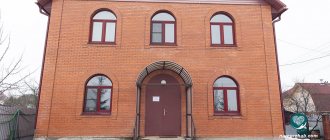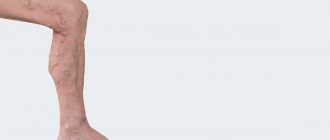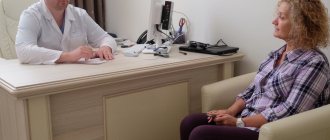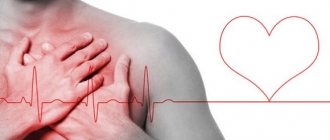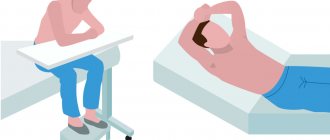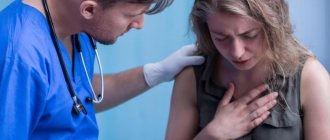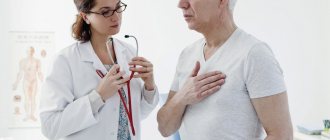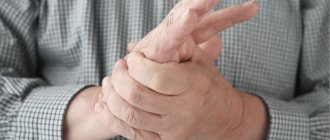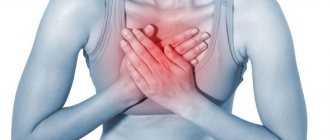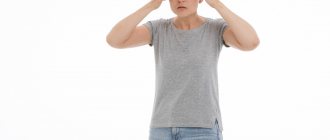People complain of pain between the shoulder blades much less often than discomfort in the lower back and neck, however, they also occur and can indicate a variety of diseases. Moreover, if pain in the lower back or neck can occur as a result of muscle strain, then discomfort between the shoulder blades is almost never of such a harmless nature, i.e. its appearance should be regarded as an unambiguous sign of the occurrence of disorders in the spine or internal organs and a reason for treatment to the doctor.
Pathologies and diseases of the spine
Below are the most common pathological conditions and diseases of the spine, accompanied by pain in the back and chest.
Osteochondrosis
Osteochondrosis, primarily thoracic, is characterized by severe pain (especially when inhaling) and symptoms such as lumbago radiating to the shoulder or scapular region, discomfort in the ribs and hypochondrium, aggravated by coughing, sneezing or laughing. Osteochondrosis (thoracic, cervical, lumbar) is caused by the following reasons: constant stay in the same position, serious physical activity (work or sports), injuries, age, sedentary lifestyle.
Intercostal neuralgia
With intercostal neuralgia, the chest and back hurt between the shoulder blades or in the middle. Acute pain in these areas is a characteristic sign of neuralgia. Discomfort is caused by hypothermia or lifting heavy things. This is perhaps the only disease that does not pose any particular danger to the body, but causes serious discomfort.
Scoliosis
Curvature of the spine due to scoliosis most often occurs in childhood, at school age, and only progresses over time if treatment is not started in time. Scoliosis not only makes our posture unattractive, but also creates serious discomfort. Pain in the chest in the middle and back appears with 3 or 4 degrees of scoliosis. Severely compressed vertebrae and the load give off sharp pain in the sternum or back.
Injuries
Any injuries sustained (spine, thoracic region or other parts of the body) cause pain in the chest (chest) or back, which can appear alternately here and there, or radiate to both areas at the same time. Injuries occur due to accidents, falls, physical injuries, etc. In such cases, it is better for a person not to move, he should not be moved if possible, since in case of serious injuries and wounds there is a high risk of internal bleeding.
Factors contributing to pain between the shoulder blades
Painful sensations in the interscapular area can occur against the background of some vertebral pathologies:
- osteochondrosis of the thoracic region;
- problems with posture (kyphosis, scoliosis, kyphoscoliosis);
- spondyloarthrosis;
- humeroscapular periarthrosis;
- protrusion and intervertebral hernia in the thoracic region;
- intercostal neuralgia;
- radiculitis;
- spinal column injuries.
Problems in the functions of the spine can develop:
- during sedentary work;
- in the absence of sports;
- under significant loads for which the body is not ready.
More than one spine may be the source of the problem. Painful manifestations may occur against the background of disturbances in the functioning of internal organs. For example, the presence of cardiac pathologies: angina pectoris, coronary artery disease.
In addition, pain syndrome can develop against the background of:
- hepatitis A;
- cholecystitis;
- peptic ulcer in the stomach;
- pulmonary diseases;
- infectious pathologies.
Often, people who move little due to the specific nature of their work activity have to face a similar problem, since their muscular and ligamentous systems are weakened, and the muscle fibers in the shoulder girdle are tense for a long time. Such pain often bothers drivers, garment factory workers, etc.
Cardiovascular diseases
The appearance of any pain in the chest area should alert you, because our most important organs are located here - the heart and lungs. Pain, depending on the disease, can be constant or intermittent, long-term or short-term, and accompanied by other symptoms. If you have problems with the stomach or pancreas, the pain often radiates to the lower thoracic region. Pain syndrome occurs during myocardial infarction
, angina pectoris, pneumonia, bronchitis,
diaphragm hernia
, stomach ulcer, oncology, etc.
Myocardial infarction
With myocardial infarction, the chest and back between the shoulder blades begin to hurt, and the pain can radiate to the left arm or shoulder, as well as to the jaw on the left side.
Angina pectoris
With angina pectoris, a characteristic pressing pain and burning sensation appears in the sternum, and sometimes radiates to the area of the shoulder blades.
Pericarditis
It manifests itself as a sharp change in body temperature, inflammatory processes in the heart area and pain on the left side of the chest.
Myocarditis
The disease is characterized by piercing, aching pain in the chest, as well as gradually appearing weakness throughout the body and difficulty breathing.
Nature of pain
When contacting a doctor, the patient must describe in detail the pain he is experiencing. This will help make the diagnosis easier.
The duration of the pain syndrome can be:
- acute course - characterized by a sudden appearance and the same disappearance;
- chronic course - the sensations are usually mild, aching in nature, disturbing for a long time.
Painful sensations in the interscapular region near the sternum may indicate the presence of an intervertebral hernia, scoliosis or kyphosis. The severity of pain varies. In the mornings they usually do not bother you, but in the evening hours they begin to increase. In the morning, pain may bother you with osteochondrosis, when the patient was resting in an uncomfortable position. Discomfort increases while turning the head.
When pain between the shoulder blades is caused by coronary heart disease, taking nitroglycerin should help relieve it. Against the background of pulmonary pathologies, elevated temperature, cough, and intoxication are observed. Pain that appears when inhaling during a cough may indicate intercostal neuralgia. Painful sensations of a girdling, paroxysmal nature. When you feel the damaged area between the shoulder blades, a feeling of pain appears. The pain increases with physical activity and when walking.
Painful manifestations during inhalation can also occur with pulmonary diseases. In this case, the patient notes the occurrence of general weakness, fatigue, and possibly lack of appetite. If the pain syndrome in the shoulder blade on the right increases, even during a shallow inhalation, the development of a diaphragmatic abscess can be suspected.
The appearance of sharp pain indicates an inflammatory process or infringement of nerve receptors. An increase in pain when tilting the head indicates inflammation of the muscle tissue and damage to the ligamentous tissue in the interscapular region.
Pulling, dull pain is characteristic of problems with ligaments and the musculoskeletal system (with osteochondrosis of the thoracic or cervical region, myofascial syndrome). An aching pain syndrome almost exclusively indicates the presence of problems with the spine (kyphoscoliosis, fibromyalgia, spondyloarthrosis, etc.).
When painful sensations are associated with eating food, the source of the problem is dysfunction in the digestive tract (ulcer). Against the background of this pathology, a Ranitidine tablet or a warm heating pad applied to the back area will help relieve discomfort. In addition, this disease is accompanied by nausea, vomiting, heartburn, and flatulence.
In pregnant women, pain is often caused by an increase in the load on the spine. To eliminate it, it is usually enough to just rest. If you experience rapid fatigue or an increase in temperature, you may suspect the development of more serious problems (for example, pyelonephritis, pneumonia).
Oncological diseases
With cancer, pain appears in different areas of the body and can change location regardless of the location of the tumors. Typically, pain appears in the later stages, when the pathology has spread widely and caused serious harm to the person. The entire chest may hurt with lung cancer, and the pain is worst when you cough or breathe quickly. Another symptom of lung cancer may be coughing up blood. In women with breast cancer, there is pain in the chest and radiates to the back.
Backache
Types of back pain depending on the cause
Pain sensations are primary and secondary; each of these types can be caused by a wide range of conditions and diseases.
In this article we will try to consider only the most basic ones. 1. Nonspecific (primary). This type of pain has a direct connection with problems in the spine and surrounding tissues.
Causes of back pain associated with the spine:
- Scoliosis. Poor posture, leading to gradual curvature of the spine, displacement of the vertebrae and muscle strain.
- Osteochondrosis. The cause of the development of the disease is a decrease in the shock-absorbing capacity of the spine: damage to the intervertebral discs, rupture of the fibrous ring and, as a consequence, infringement of the disc nucleus. Pain sensations are localized in the area of the spine in which there are pathological changes. So, with osteochondrosis of the thoracic spine, back pain is localized in the thoracic region (the back hurts between the shoulder blades and under the ribs); with osteochondrosis of the lumbar spine, a person experiences pain in the lumbar region.
- Intervertebral hernia. Due to damage to the intervertebral disc, protrusion of the soft structures of the vertebrae occurs with the possibility of strangulation (regular and strangulated hernia). The pain is localized at the site of the hernia.
- Ankylosing spondylitis. It is characterized by back pain and limited mobility in the spine, which leads to a forced “leaning forward” posture in the patient.
- Osteomyelitis. The cause of the disease is an infectious process that has developed in the spinal column. The patient feels that the pain affects not only the spine, but also the back muscles.
- Spinal injuries. In this case, the cause of back pain is injury and its accompanying complications. The intensity of pain and its location are directly related to the type of injury and the affected part of the spinal column.
In 40–50% of cases, the causes of back pain are damage to the joints and ligaments of the spine (skeletal pain). Another 3–5% of severe back pain is associated with damage to the roots of the spinal cord (radicular pain).
Back pain associated with pathological changes in muscles:
- Fibromyalgia. The inflammatory process develops in the muscles surrounding the spine, is characterized by symmetry and can be chronic. In this case, the back muscles along the entire spine hurt. The important point is that peak pain occurs when certain areas are pressed.
- Polymyositis. Hypothermia can trigger the disease. As a result of the development of the disease, the patient experiences muscle weakness and pain, which intensifies when trying to make a turn.
- Polymyalgia rheumatica. The etiology of the disease is not clear. Infectious diseases that lower immunity can serve as a trigger. It manifests itself as pain that increases as the disease progresses and can cover all areas of the back. Severe back pain impairs mobility to such an extent that the patient is unable to move independently. A clear asymmetry is visualized in the back.
- Charcot's disease. Symptoms are caused by inflammation in the peripheral nerves along the spinal column. As a result of the pathological process, in addition to fairly intense pain, there is a change in the person’s gait.
In 50–60% of cases of nonspecific back pain, their localization is in the muscles.
2. Specific (secondary pain). This type of pain, despite its localization in the back, is often not directly related to diseases of the spinal column or the surrounding muscular skeleton. The causes of specific pain are extremely varied, but the most dangerous are cancer. Thus, pain radiating to the back can be caused by a malignant neoplasm in the area of the mammary glands, lungs or prostate, which provokes metastasis of the spine.
Diseases that cause specific pain include:
- Pinched nerve roots in the chest. Most often this leads to the development of intercostal neuralgia. The pain in this case is localized at the pinched site. Thus, intercostal neuralgia can manifest itself: pain under the shoulder blades, pain in the back under the ribs (on the side where the pinching occurred). Soreness has varying degrees - from aching to sharp, shooting. Most often, pain occurs when moving or pressing on the affected area. This fact is the main difference between intercostal neuralgia and diseases of the heart and lungs, which can also manifest as pain under the left (or right) shoulder blade from the back.
- Diseases of the gastrointestinal tract. Pain is most often provoked on the right side; in some cases, it can spread to the left side of the body. For the most part, pain is localized in the lumbar and sacrolumbar regions. Quite strong pain is characteristic of pathologies associated with manifestations of diseases of the pancreas, colon diverticulum, intestinal obstruction, retrocecal appendicitis, etc.
- Ulcerative lesions. Ulcerative lesions of the organs of the upper abdominal cavity (peptic ulcer of the duodenum and stomach) can manifest themselves in the form of pain in the thoracic and lower lumbar back. If the lower part of the abdominal cavity is affected (ulcerative colitis), pain is localized in the lumbar region. The severity of pain may vary, but most often reaches its peak at night.
- Appendicitis. In acute appendicitis, in cases where the vermiform appendix (appendix) is located behind the cecum, the back hurts in the lumbar region. The pain is alternating in nature and can vary from aching, mild to acute, intense.
- Kidney diseases. Quite often they manifest themselves as pain in the lumbar region. This type of manifestation is characteristic of pyelonephritis and chronic glomerulonephritis. Differentiation from pathologies that have a direct connection with the spinal column occurs based on the analysis of other clinical manifestations and research results.
- Urolithiasis disease. With renal colic, the back hurts in the lumbar region. The pain is pronounced, intense, occurs suddenly and does not depend on the position of the body. Back pain in the lower back and with coral nephrolithiasis. Manifestations of the pain syndrome are low-intensity, the pain is rather aching in nature.
- Diseases of the female reproductive system and menstrual pain. In these cases, the pain is most often localized in the lower back.
- Neoplasms in the pulmonary system. In this case, pain appears at the stage when the lungs undergo germination of peripheral tumor elements (metastases) into the pleural area and chest wall. The nature of the pain is intense and debilitating.
- Cardiovascular diseases. The most common causes of pain localized in the thoracic back are myocardial infarction and stroke. As a rule, these diseases are accompanied by pain between the shoulder blades.
- Inflammatory processes in the joints. Infectious arthritis can cause pain to radiate from the affected joint to nearby areas, including back pain.
For the most part, the causes of pain in the back are identical for representatives of both sexes, but it is necessary to identify a number of diseases that differ in gender predisposition.
Back pain in men
Although the causes of back pain are mostly the same for both sexes, there are a number of diseases that men are more susceptible to due to their lifestyle.
Such predisposing factors include:
- work that involves lifting and carrying heavy objects;
- strength sports (including various martial arts, powerlifting, etc.);
- bad habits.
As a result, diseases of the musculoskeletal and cardiovascular systems may occur more often in men than in women.
Specific “male” diseases that can cause back pain are various prostate pathologies.
Prostatitis is an inflammatory disease of the prostate gland. At the beginning of the disease, the pain syndrome is localized in the groin, scrotum and lower abdomen, but in the second stage and in cases where the disease has become chronic, the pain spreads to the back.
The localization of pain in this case can either be concentrated in the lumbosacral region or spread to the entire back. This is due to the fact that the inflammatory process affects the nerve endings, which envelop this organ in large quantities. The intensity of pain is directly related to the stage of the disease. Thus, in the acute phase, pain is characterized as acute and short-term. In the chronic form, the pain syndrome is not very pronounced and is often permanent.
In this case, a urologist makes a diagnosis and prescribes treatment.
Back pain in women
In some cases, back pain in women may have a specific nature associated with the characteristics of the body and the processes occurring in it. We are talking primarily about the reproductive sphere.
As a rule, pain associated with gynecological diseases is localized in the thoracic and lumbosacral regions. The most common reasons include:
1. Menstrual cycle. During menstruation, a woman's hormonal background changes, which leads to a number of negative manifestations. This is primarily due to a decrease in the level of progesterone, which is responsible for the intensity of the pain threshold. A decrease in the pain threshold leads to the fact that even minor pain sensations become more pronounced. Also, hormonal changes lead to irritation of the intestinal walls and fluid retention, which provokes an increase in the volume of some organs and, as a result, compression of the nerve endings of the lumbar spine. The combination of these factors provokes the occurrence of back pain.
2. Pregnancy. Lower back pain in this case can be divided into two groups:
– First trimester pain. If painful sensations are accompanied by additional symptoms (bloody discharge, increased body temperature, etc.), we may be talking about the risks of miscarriage. – Pain in the second half of pregnancy. Most often, such pain is associated with physiological changes, namely: active growth of the fetus, provoking a change in the center of gravity in the position of the body, and preparation of the pelvis for the upcoming labor. 3. Diseases of the reproductive system. Most of the pain is concentrated in the lumbar region, which is explained by the topography of the female reproductive organs. The most common causes of this manifestation of pain are ovarian cysts, adnexitis, ectopic pregnancy, endometriosis, etc. 4. Menopause. During menopause, powerful changes and fluctuations in hormonal levels occur. Such a restructuring of the body leaves its mark on many systems of the female body. First of all, the skeletal system suffers, which, under the influence of hormonal changes, becomes more fragile and susceptible to various kinds of diseases. 5. Large breasts. A large bust size in combination with poorly supporting underwear creates additional stress on the spinal column, and, as a result, a woman has back pain in the area of the shoulder blades and lower back. 6. High heels. Wearing high-heeled shoes leads to the development of a number of diseases associated with pathological changes in the musculoskeletal system and back pain.
Back pain due to coronavirus
Coronavirus infection leads to damage to many organs, but the lungs are primarily affected. Therefore, pain between the shoulder blades or under them is often a manifestation of inflammation that has developed in the lung tissue. Depending on which lung is more affected, the patient will feel pain under the left or right shoulder blade.
In addition to damage to the lung tissue, there is general intoxication of the body and an increase in temperature, which can also cause pain (ache) in the back and limbs.
Back pain after coronavirus is explained by the fact that the disease can not only damage the nervous system, but also, against the background of a general decrease in immunity, chronic diseases, including internal organs and the musculoskeletal system, worsen.
Back pain after sleep
The reasons why your back hurts after sleep can be:
- work involving physical activity and heavy lifting;
- low back muscle tone;
- history of intervertebral hernia and osteochondrosis;
- prolonged hypothermia of the back;
- curvature of the spine, leading to muscle strain and uneven contraction;
- excess body weight, resulting in increased load on the back area;
- stressful situations;
- uncomfortable sleeping place.
Unpleasant sensations can have varying intensity and appear under the ribs, in the lower back, between and under the shoulder blades.
To eliminate pain that occurs after sleep, it is necessary to exclude all provoking factors and consult a doctor to prescribe treatment.
Back pain - which doctor should I contact?
The primary diagnosis of pain in the back area is carried out by a general practitioner. If necessary, a number of additional examinations and consultation with highly specialized specialists may be prescribed:
- neurologist;
- gastroenterologist;
- gynecologist;
- urologist;
- pulmonologist.
To make an accurate diagnosis, it is necessary to conduct a detailed analysis of the patient's condition. For these purposes, the doctor may prescribe a number of additional studies:
- Lab tests. Most often, this list includes general and biochemical blood tests, urine and stool tests, and in some cases, analysis of hormone levels. These studies help identify possible inflammatory processes and infections. If certain diseases or an oncological component are suspected, the doctor may prescribe a number of specific studies (biopsy, tumor markers, etc.).
- Hardware research. They help to obtain a more clear picture of the course of the disease, which cannot be achieved with visual examination and palpation. The most commonly prescribed are radiography, MRI, and ultrasound.
Treatment of back pain
To prescribe qualified treatment, a face-to-face consultation with specialists is necessary. Therapy is selected strictly based on the diagnosis and taking into account the general condition of the patient. Self-treatment of back pain can lead to progression of the disease or transition to the chronic stage.
Prevention of back pain
Basic preventive measures depend primarily on what exactly triggered the appearance of back pain. Some general recommendations include:
- healthy lifestyle;
- nutritious and healthy nutrition;
- reasonable dosage of physical activity;
- timely treatment of identified diseases;
- Regular preventive examinations, including from specialized specialists.
Diagnostics
Since pain in the back and chest can simultaneously be a sign of a large number of diseases and pathologies, it is possible to make an accurate diagnosis only after conducting examinations and passing the necessary tests. The list of diagnostic measures is compiled by the doctor. You cannot engage in self-diagnosis and self-medication. What may be included in the diagnosis when a patient presents with the following complaints:
- collecting information about the patient’s problem and health status;
- examination, which includes listening to the heart and lungs, measuring blood pressure and pulse;
- X-ray, which makes it possible to evaluate the work and condition of the heart, lungs, spine and ribs;
- An ECG
is prescribed to evaluate heart function; - CT and MRI
make it possible to clarify the condition of internal organs and the presence of pathologies; - FEGDS and gastroscopy are prescribed for problems with the gastrointestinal tract.
Laboratory tests may also be ordered. An accurate diagnosis can only be made by a doctor after a complete examination of the patient.
Therapeutic measures in a hospital setting
It is not recommended to treat yourself. It is better to seek the help of specialists and undergo complex treatment, which will be selected by the doctor according to an individual scheme.
Complex therapy involves the use of medications in combination with physiotherapeutic procedures and therapeutic exercises.
If there is an inflammatory process, the doctor prescribes a course of NSAIDs (Movalisa, Dicloberla). To eliminate muscle spasms, muscle relaxants (Baralgin, Mydocalm, Sirdalud) are indicated. When the cause of pain in the interscapular area lies in problems with internal organs, the doctor selects medications from certain pharmacological groups. In this case, antibiotics, hepatoprotectors, diuretics, analgesics, etc. are indicated.
Along with medications, physiotherapeutic procedures may be recommended:
- laser therapy;
- acupuncture;
- electrophoresis using lidase and novocaine;
- massage;
- magnetic therapy.
The gymnastic complex is prescribed on an individual basis, taking into account the characteristics of the pathology, the nature of the pain, and the patient’s well-being.
Treatment
Treatment is selected depending on the diagnosis and may include both outpatient medication and hospitalization with surgery. The patient can also be prescribed and selected diet, physical activity and other measures for recovery, rehabilitation and reduction of symptoms and pain relief. The timing and number of treatment methods used are individual. If you have pain in the chest and back, go to the doctor. If you consult a neurologist
the problem can be solved either completely or the risk of complications and further health problems can be significantly reduced.
Adviсe
Since the cause of pain is often spinal diseases, in order to keep the spine healthy, it is recommended:
- try not to stay in one position for a long time;
- play sports (but in moderation);
- avoid hypothermia;
- ensure uniform load distribution;
- do not strain muscle tissue too much;
- ensure that your diet is balanced.
Pain in the interscapular area can indicate the development of many diseases. This can be either a disease of the spinal column or problems with internal organs. It is impossible to determine the source of the problem on your own. To do this, you need to consult a doctor, undergo an appropriate examination and begin treatment prescribed by the doctor.
Diagnostic measures
Our specialists will make a more precise diagnosis after carrying out the necessary laboratory and instrumental diagnostics using the most modern equipment. When indicated, the following will be carried out:
- blood tests;
- urine test to evaluate kidney function;
- performing liver function tests;
- gastric endoscopy;
- Ultrasound for diagnosing somatic disorders, cardiac and vascular conditions;
- CT scan of the liver, pancreas;
- ECG of the heart;
- X-ray of the sternum.
Based on the fact that pain under the left shoulder blade from the back may not be a symptom of a single disease, a comprehensive examination by several specialists is not excluded. Our clinic offers patients one of the modern comprehensive types of examination - check-up, which includes many types of tests with the smallest set of diagnostic procedures. Timely contact with our specialists and a guaranteed correct diagnosis will help the patient undergo high-quality and successful treatment.
